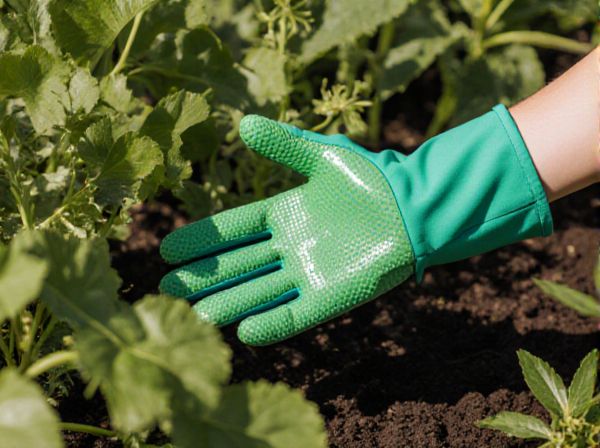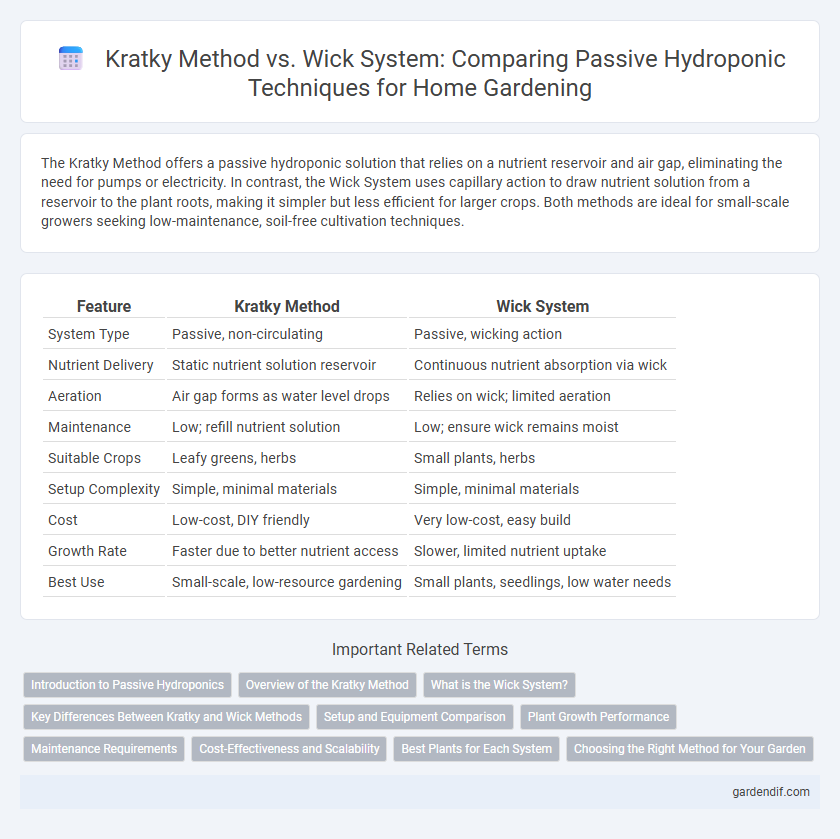
Kratky Method vs Wick System Illustration
The Kratky Method offers a passive hydroponic solution that relies on a nutrient reservoir and air gap, eliminating the need for pumps or electricity. In contrast, the Wick System uses capillary action to draw nutrient solution from a reservoir to the plant roots, making it simpler but less efficient for larger crops. Both methods are ideal for small-scale growers seeking low-maintenance, soil-free cultivation techniques.
Table of Comparison
| Feature | Kratky Method | Wick System |
|---|---|---|
| System Type | Passive, non-circulating | Passive, wicking action |
| Nutrient Delivery | Static nutrient solution reservoir | Continuous nutrient absorption via wick |
| Aeration | Air gap forms as water level drops | Relies on wick; limited aeration |
| Maintenance | Low; refill nutrient solution | Low; ensure wick remains moist |
| Suitable Crops | Leafy greens, herbs | Small plants, herbs |
| Setup Complexity | Simple, minimal materials | Simple, minimal materials |
| Cost | Low-cost, DIY friendly | Very low-cost, easy build |
| Growth Rate | Faster due to better nutrient access | Slower, limited nutrient uptake |
| Best Use | Small-scale, low-resource gardening | Small plants, seedlings, low water needs |
Introduction to Passive Hydroponics
The Kratky Method and Wick System are two popular passive hydroponic techniques that require no electricity or pumps, making them ideal for beginners. The Kratky Method involves suspending plant roots above a nutrient reservoir, which decreases as plants consume the solution, while the Wick System uses a wick to draw nutrient solution up to the plant roots from a reservoir. Both methods offer low-maintenance setups, but the Kratky Method generally supports larger plants and faster growth due to better oxygen availability.
Overview of the Kratky Method
The Kratky Method is a passive hydroponic technique that requires no pumps or electricity, making it an efficient and low-maintenance option for growing plants. It relies on a fixed nutrient solution level that gradually decreases as plants absorb water and nutrients, creating an air gap for root oxygenation. This method is especially suitable for leafy greens and herbs, offering simplicity and cost-effectiveness compared to more complex systems like the wick system.
What is the Wick System?
The Wick System is a passive hydroponic technique that uses a wick to draw nutrient solution from a reservoir to the plant roots, ensuring consistent moisture without pumps or electricity. It is best suited for small, low-maintenance plants such as herbs or leafy greens. Compared to the Kratky Method, the Wick System relies on capillary action and requires less water but may deliver nutrients more slowly.
Key Differences Between Kratky and Wick Methods
The Kratky Method is a passive hydroponic system that relies on a static nutrient solution and air gap to oxygenate roots, while the Wick System uses a passive capillary action via a wick to deliver nutrients from a reservoir. The Kratky Method requires minimal maintenance and no electricity, making it ideal for beginners, whereas the Wick System can face challenges with wick clogging and slower nutrient delivery. Root oxygenation is more efficient in the Kratky Method, supporting faster growth compared to the Wick System's limited oxygen supply.
Setup and Equipment Comparison
The Kratky Method requires minimal setup with a non-circulating passive hydroponic system using a simple container, net pot, and nutrient solution, eliminating the need for pumps or electricity. The Wick System involves a more complex setup including a reservoir, wicking material, and growing medium to draw nutrient solution to the plants, suitable for smaller plants but less efficient in oxygen delivery. Equipment costs for Kratky are generally lower due to its simplicity, while the Wick System necessitates careful selection of wick and medium materials to maintain consistent moisture levels.
Plant Growth Performance
The Kratky Method promotes faster plant growth by providing a passive, oxygen-rich water environment that prevents root rot and supports nutrient uptake without continuous water circulation. In contrast, the Wick System relies on capillary action to deliver nutrients, which can limit oxygen availability and reduce growth rates in larger or more demanding plants. Studies indicate that plants grown using the Kratky Method generally exhibit higher biomass and healthier root systems compared to those cultivated with the Wick System under similar conditions.
Maintenance Requirements
The Kratky Method requires minimal maintenance due to its passive design, with no need for pumps or moving parts, reducing the frequency of system checks and adjustments. In contrast, the Wick System demands regular monitoring to ensure wicks remain saturated and free of blockages, as inadequate moisture can stress plants. Both methods benefit from periodic nutrient solution replacement, but the wick system's dependence on capillary action makes it more sensitive to environmental changes.
Cost-Effectiveness and Scalability
The Kratky Method offers a highly cost-effective hydroponic solution by requiring no pumps or electricity, making it ideal for small-scale growers seeking low maintenance. In contrast, the Wick System, while also low-cost and simple, tends to be less scalable due to limited nutrient delivery efficiency, which can restrict plant growth in larger setups. For scalability and budget-conscious farming, the Kratky Method provides a more efficient and practical approach to expanding hydroponic cultivation.
Best Plants for Each System
Leafy greens such as lettuce, spinach, and herbs thrive in the Kratky Method due to its passive, nutrient-rich water reservoir that supports steady root development. The Wick System is best suited for smaller, low-water-demand plants like herbs and baby greens, benefiting from its capillary action that draws nutrients continuously. Both methods favor plants with relatively low nutrient and water requirements, but the Kratky Method accommodates larger plants better than the Wick System.
Choosing the Right Method for Your Garden
The Kratky Method offers a no-pump, passive hydroponic solution ideal for growing leafy greens with minimal maintenance, using a reservoir that gradually depletes nutrient solution as plants absorb water. The Wick System relies on capillary action to deliver nutrients and water through a wick from the reservoir to the plant roots, making it suitable for small-scale setups but less effective for larger or water-intensive crops. Selecting the right method depends on factors like plant type, available space, maintenance willingness, and the desired scale of your hydroponic garden.
Kratky Method vs Wick System Infographic

 gardendif.com
gardendif.com